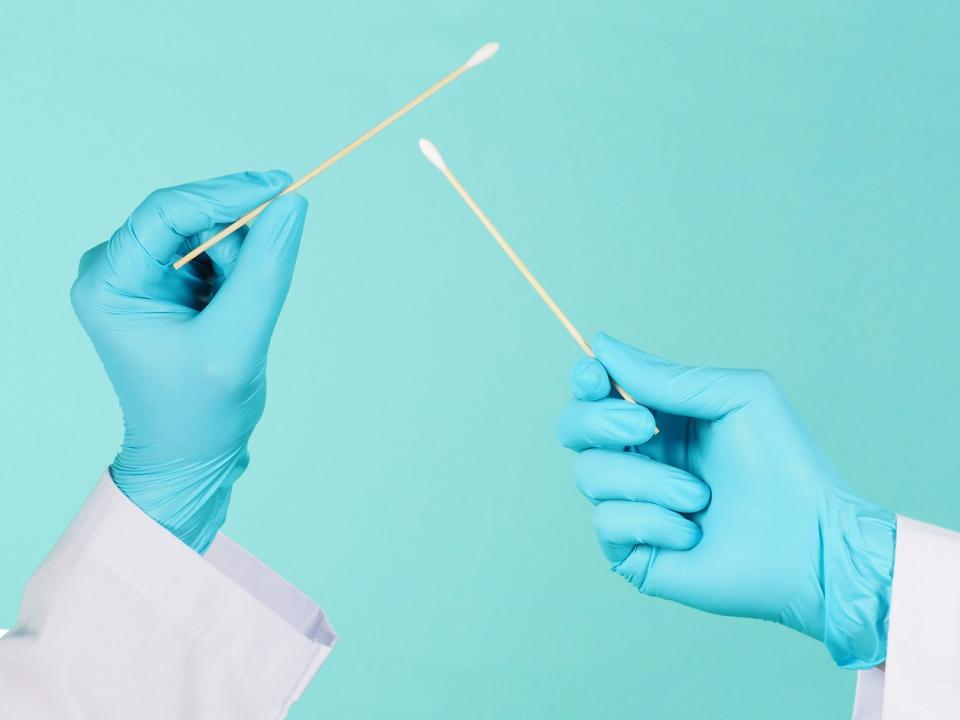How to Know When to Use a Rapid Test or PCR Test for COVID-19
No one is really excited about a nasal swab or spitting in a tube, but now that testing has become the next front in the war against COVID-19, rapid tests (now available for free through COVIDtests.gov) and PCR tests can help us reduce the odds that we pass on the illness to someone else.
PCR and rapid tests each work differently. The PCR (which stands for polymerase chain reaction) test looks for genetic material from the virus, while the rapid test looks for viral antigens, a type of protein that's on the surface of the virus. Usually, it takes a couple of days for the lab to process a PCR test, while you can get your rapid test results in under 30 minutes. So depending on the reasons why you're taking a test at a particular moment, you may opt for one over another.

Getty Images
"The biggest advantage of rapid antigen tests is that they are fast, cheap, and a reliable way for you to find out if you're spreading the virus," says Vivek Cherian, MD, an internal medicine physician in Chicago. "A PCR test is more sensitive and can actually identify an infection sooner, but the downside is that it can take a few days to get your result."
When you're deciding how (or when) to test, remember that the tests only represent your status at the moment you take them. "These tests only tell you about one point in time, so a negative test yesterday could be a positive test today," says Larissa Pisney, MD, medical director of infection prevention and control at UCHealth in Denver, Colo.
To choose the test that's best for your particular situation, follow these guidelines.
If you're experiencing symptoms: Rapid or PCR test
If you develop a headache, sore throat, fever, or other common COVID symptoms, the CDC recommends that you assume you have COVID and get tested. A rapid test may give you a more immediate answer, but a PCR test will give you a more definitive one. "Rapid tests are best used when someone has symptoms of COVID, and even then if it is negative, I would recommend getting a PCR to confirm," Dr. Pisney says. "A positive rapid test does not need to be confirmed with a PCR."
If you've been exposed to someone with COVID: Rapid or PCR test
Either test would be a good option in this scenario, though there's an advantage to the rapid test: "It can prompt a person to isolate sooner, and thereby prevent you from spreading the virus earlier," Dr. Cherian says.
But for the highest degree of accuracy, a PCR test will be best. "For high-risk exposures, I would recommend a PCR if you have access to one," Dr. Pisney says. "A PCR test is going to be the most sensitive way to detect an infection."
The CDC recommends waiting at least five days after exposure (or until symptoms emerge), if you've been exposed to someone with COVID.
If you're getting together with a group: Rapid test
A rapid test just before you get together with friends (especially if you take it just before you head inside) offers you a quick snapshot of whether you're currently infectious. "I have used them before gatherings with family and friends as an extra layer of protection," Dr. Pisney says. "It is important to know that false negatives can happen, so using them is not a foolproof strategy."
If you need to prove your COVID status: PCR test
Because PCR tests are lab-certified, they're more likely to be accepted as proof of a negative (or positive) result than a test done at home.
If you want to know if you're still infectious after developing COVID: Rapid test
A PCR test will not be an accurate gauge of whether you are still infectious after a COVID illness.
"Past day 10 or so, a PCR test is not going to be helpful because you may have completely cleared the virus out of your system, but the test may still read as positive because it still may be detecting viral debris, or in other words, dead virus," Dr. Cherian says.
That positivity can continue for longer than you'd expect—up to 90 days after an initial infection, Dr. Pisney says.
If you're traveling: PCR test
PCR (also known as molecular) tests are required by many international destinations—so if you're traveling out of the country, you'll need to have a negative test, generally taken within 72 hours of your travel. Some countries may require additional testing and quarantining for a few days once you arrive. And even for U.S. citizens traveling to Hawaii, a negative PCR test or proof of full vaccination is required to avoid quarantine upon arrival.
Because the rules around this change quickly, it's best to check the website of your intended destination in the week before your visit to see what's currently being required, so you can plan your testing accordingly.
And it's a good idea to test after you've traveled, just to make sure you aren't bringing an infection back to your community—either a PCR or rapid test could work for this, Dr. Pisney says.

 Yahoo Movies
Yahoo Movies 
